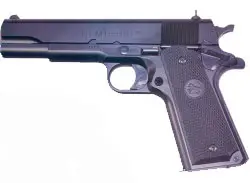|
Colt M1991 Government Model Pistol By Chuck Hawks  The Colt Series 80, M1991 Government Model incorporates a few modern improvements compared to the original M1911 Government Model pistol. Among the most noticeable of these are an extended tang on the grip safety to help prevent hammer "bite" and improved Patridge-type sights for faster, more accurate aiming. The ejection port has been slightly enlarged for more reliable function. Otherwise, this pistol looks much like the old fashioned military veteran. Its overall Parkerized finish and checkered black plastic grips reinforce this utilitarian image. Even its model nomenclature, M1991, evokes its military heritage, and is only one digit different than the Colt WW1 original (M1911). The M1991 even has the straight rear grip line of the original 1911 model. Sargent Alvin Cullum York (1887-1964), who used a M1911 to good effect during the Argonne-Meuse offensive while winning the Medal of Honor in WW I, would have recognized this pistol instantly. Like other modern Colt M1911 pistols, the M1991 has several safety devices. There is a conventional frame-mounted manual safety at the left rear of the frame that locks the slide and sear when engaged. Push this slide lock safety up for "safe" and down for "fire." There is also a grip safety located on the upper rear part of the grip frame. There is a safety stop (quarter cock) position on the hammer, designed to catch the hammer should it slip from under the thumb while being cocked. Note that this is not a hammer safety notch and that the hammer can be dropped from this position by simply pulling the trigger. There is a disconnector that prevents a round being fired before the barrel and slide are locked. Last, there is an automatic firing pin lock. This pistol is not equipped with a magazine safety. It can be fired with the magazine removed from the pistol. The most important safety is between the shooter's ears. Make sure this device is engaged and fully operational before operating any firearm. And keep your finger off of the trigger until the pistol is aligned, downrange, with the target. The main controls on the M1991 pistol are the trigger (forward of upper grip), the slide lock safety (at left rear of slide), the hammer (at rear of slide), magazine catch button (at lower left rear of trigger guard), and the slide stop/takedown lever (left side of frame above trigger). All of these operate in the conventional, expected manner. When the magazine catch is depressed, the magazine will drop free of the gun. To reload, place a cartridge on the magazine follower with the base just forward of the retaining lips. Press each cartridge down into the magazine and back until the rim of the case is against the flat rear edge of the magazine. This is a single action pistol, meaning that the hammer must be manually cocked before the trigger can be pulled to fire the first shot. The hammer cannot be cocked by pulling on the trigger. Each time the pistol is discharged by pulling the trigger, the hammer will be automatically re-cocked and the chamber reloaded by the movement of the slide. The slide stays open after the last shot is fired. Here are the basic specifications of the Colt M1991 pistol:
Despite its dull Parkerized finish, the M1991 is fundamentally a very high quality pistol. The major components, including the slide and grip frame, are forged and machined from steel. In fact, aside from the composite grip components (both side panels and the rear grip frame insert), all parts are made from steel. The trigger pull of the test pistol measured 6.25 pounds by my RCBS Premium pull gauge. There was also a little creep, but the biggest problem from the standpoint of accurate shooting was the excessive weight of pull. It is pretty hard to pull 6.25 pounds against a 2.4 pound pistol without moving it. At the range, the Colt M1991 functioned perfectly with all types of ammunition, which cannot be said of many M1911 clones. Some of those modern clones of this famous Colt pistol will shoot tighter groups out of the box. But check them again after, say, 50 years of hard use before you conclude that they are better (or anywhere near as good) as a genuine Colt. Note: A complete review of the Colt M1911 can be found on the Product Reviews page. |
Copyright 2005, 2016 by Chuck Hawks. All rights reserved.
|
|